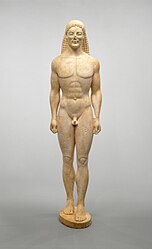File:Kouros - Getty Museum (85.AA.40).jpg

Original file (2,874 × 4,714 pixels, file size: 2.99 MB, MIME type: image/jpeg)
| This is a file from the Wikimedia Commons. Information from its description page there is shown below. Commons is a freely licensed media file repository. You can help. |
Summary
Object
| Getty Kouros
|
|||||||||||||||||||||||||||
|---|---|---|---|---|---|---|---|---|---|---|---|---|---|---|---|---|---|---|---|---|---|---|---|---|---|---|---|
| Artist | |||||||||||||||||||||||||||
| Title |
Getty Kouros label QS:Lpt,"Kouros Getty"
label QS:Lfr,"Kouros de Getty"
label QS:Lfi,"Gettyn kuros"
label QS:Len,"Getty Kouros"
label QS:Lde,"Getty kouros"
label QS:Lzh,"盖蒂的库洛斯雕像"
label QS:Les,"Kuros de Getty" |
||||||||||||||||||||||||||
| Object type |
statue |
||||||||||||||||||||||||||
| Genre |
kouros |
||||||||||||||||||||||||||
| Description |
|
||||||||||||||||||||||||||
| Date |
530 BC date QS:P,-0530-00-00T00:00:00Z/9 |
||||||||||||||||||||||||||
| Medium |
marble |
||||||||||||||||||||||||||
| Dimensions |
height: 206.1 cm (81.1 in) dimensions QS:P2048,+206.1U174728 dimensions QS:P2049,+54.6U174728 dimensions QS:P5524,+51U174728 |
||||||||||||||||||||||||||
| Collection |
institution QS:P195,Q180401 |
||||||||||||||||||||||||||
| Current location |
Not currently on view |
||||||||||||||||||||||||||
| Accession number |
85.AA.40 (J. Paul Getty Museum) |
||||||||||||||||||||||||||
| Place of creation |
Ancient Greece |
||||||||||||||||||||||||||
| References |
J. Paul Getty Museum object ID: 103VNP |
||||||||||||||||||||||||||
| Authority file | |||||||||||||||||||||||||||
Photograph
| DescriptionKouros - Getty Museum (85.AA.40).jpg | ||||
| Source |
The Getty Center, Object 103VNP
|
|||
| Author | J. Paul Getty Museum | |||
| Permission (Reusing this file) |
|
Captions
Items portrayed in this file
depicts
File history
Click on a date/time to view the file as it appeared at that time.
| Date/Time | Thumbnail | Dimensions | User | Comment | |
|---|---|---|---|---|---|
| current | 04:21, 11 March 2024 |  | 2,874 × 4,714 (2.99 MB) | DEGA MD | Uploaded a work by The J. Paul Getty Museum from Villa Collection with UploadWizard |
File usage
Global file usage
The following other wikis use this file:
- Usage on www.wikidata.org
Metadata
This file contains additional information, probably added from the digital camera or scanner used to create or digitize it.
If the file has been modified from its original state, some details may not fully reflect the modified file.
| Author | The J. Paul Getty Museum |
|---|---|
| Image title |
|
| Short title |
|
| Credit/Provider | The J. Paul Getty Museum, Villa Collection, Malibu, California |
| Source | The J. Paul Getty Museum |
| Usage terms | |
| Online copyright statement | http://www.getty.edu/legal/copyright.html |
| JPEG file comment | Generated by IIPImage |
| Contact information | rights@getty.edu
www.getty.edu 1200 Getty Center Drive Los Angeles, California, 90049 United States |
| Date metadata was last modified | 23:16, 13 February 2020 |
| Copyright status | Copyright status not set |



